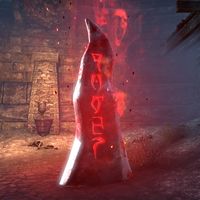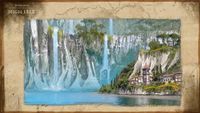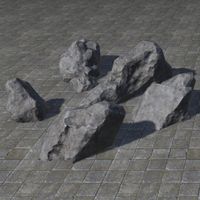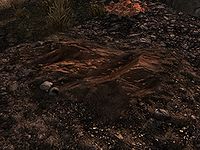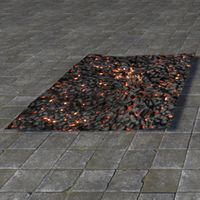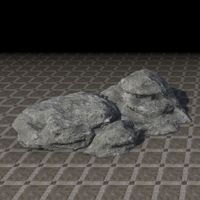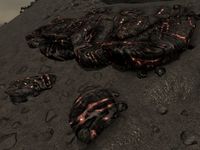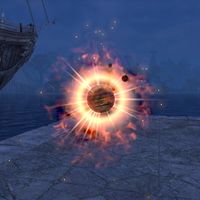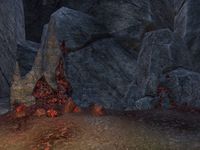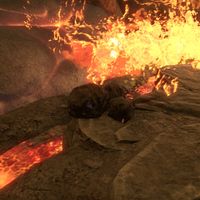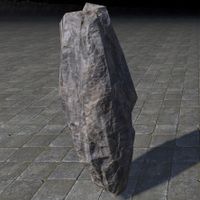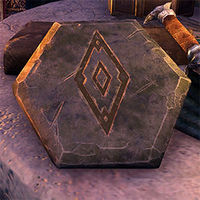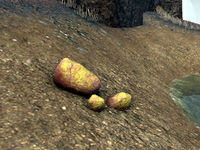Lore:Other Minerals
Agonymium[edit]
Agonymium is a type of stone that possesses the power to consume mortal misery. It is usually grey in color, but glows red when infused with the screams of mortal agony. The stone can become dormant and lose this ability.[1] Concentrating on a fragment of agonymium can cause a mortal to temporarily discorporate, splitting into slivers of individualized torment.[2] Pillars of agonymium engraved with Daedric writing were used extensively throughout the Dread Cellar.[3]
Alabaster[edit]
Alabaster is a white stone. Cliff faces made of alabaster can be found in High Isle.[4][UOL 1] The walls of the eponymous settlement of Alabaster are said to be made from it, as are some Ayleid ruins.[5][6] The Resolution of Zenithar is in possession of a hundred-foot tall obelisk made of alabaster that stands above all as a symbol welcoming commerce, and is said to be so finely polished that it reflected back shades of the sea and sky.[UOL 2]
Ammonite[edit]
Ammonites (also known as Eltheric Ammonites) are extinct aquatic mollusks once native to the Eltheric Ocean and known only for the beautiful shells they left behind. Although the true origin of these shells is unknown, the consensus among naturalists is that ammonites predate even the oldest of Merethic Era ruins.
Ammonites are most commonly harvested for use by mages and druids due to the fact that they contain stores of raw magicka. The capacity varies depending on the shell, with some only holding trace amounts of magicka and others holding nearly as much as a lesser-grade soul gem. However, ammonites cannot be recharged and suffer from arcane decay, losing potency within a month of being harvested. Nevertheless, they are an important source of magicka for magic users on High Isle, and they are an important trade good for the Systres archipelago. Untapped ammonites can sometimes be identified by the faint, shimmering glow they emit. Depleted shells become dull and do not glow or shine.
Basalt[edit]
Basalt is a heavy, coarse stone known to have formed in hexagonal pillars on Solstheim.[7][8][UOL 3] Basalt is often considered to be unsuitable for delicate stonework, but early Dunmer are known to have crafted with it regardless,[9] particularly in the walls of buildings in Vivec City.[10]
Bezoar[edit]
A Bezoar stone is a hardened mass formed in animal stomachs.
Bezoars extracted from the stomachs of Albino Guars are known to have ritualistic uses, with one notable instance being a ritual performed by the Drothmeri Army of Frathen Drothan. A pair of enchanted bezoars was used to dispel the enchantment protecting the passage to Varsa Baalim. Bezoars also find use in alchemy. Trichobezoar Extracts are potions renowned for their ability to remedy poison-related ailments and provide immunity to poisons.
Minotaur bezoars found use in the craftsmanship of the Dreadhorn Clan.
Alits were also known for their bezoars, although little is known about their properties other than the fact that they were described as shimmering.
Chalk[edit]
Charcoal[edit]
Chert[edit]
Chert is a type of rock. It was mined by Imperials.
Kingscrest Cavern, located north of Cheydinhal in the Jerral Mountains, was a known source of chert and flint, occasionally utilized by the vassals of House Tharn. By the year 2E 582, it had been abandoned and taken over by wild creatures, a state it remained in during 3E 433. A specific part of the cavern was referred to as the Chert Galleries.
Clay[edit]
Clay is a mud-like substance commonly used in pottery, porcelain,[11] and bricks.[12] It is sometimes used for skincare and to preserve mudcrabs.[13] The Orsimer are known to use it in their paints.[14] It is also sometimes used for chips for use in games.[15] In ancient times, the Argonians used clay for tablets used to inscribe Jel pictograms.[16]
Coal[edit]
Coal is brownish-black rock that is primarily used as fuel.[17] It is also used as a component in black body paint.[18] Anthracite is a variety of coal.[19]
Coprolite[edit]
Coprolite is a type of fossilized excrement or dung, often found in the form of solid, mineralized feces.
Vulk'esh excrement has a tendency to harden into dense, heavy, igneous chunks that bear a resemblance to slag. These chunks have potential applications.
Coral[edit]
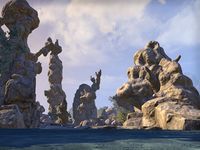
Coral is a type of aquatic rocklike structure, formed from the bones of tiny sac-animals, that comes in many different varieties.
In Sload society, it is prominently used in their architecture. Dense corals supposedly provide the entire foundation of Thras and the Coral Tower itself was made from blood-red coral before its collapse. The Sload are also said to use tangled nests of coral formations to move around, and it's even used in their armorsmithing, with different types of corals providing different advantages in battle, such as lightness or durability.
Some of the most ancient ruins of Summerset Isle are thought to have been built by the Sload and are made of coral, including the original architecture of Cloudrest. In Morrowind there is a naturally-occurring bioluminescent, and possibly sentient, coral species that grows on the lands around the Inner Sea.
Fulgurite[edit]
Fulgurite is a tube shaped rock that forms when lightning strikes sand, leaving behind a hollow structure.[20]
Gabbro[edit]
Gabbro is a type of stone.[21] It is found in Blackwood.[22]
Granite[edit]
Granite is a type of stone. The Charred Ridge is a granite mountain range that separates Stonefalls and Deshaan. The Tormented Spire is its highest peak and anchors it to the west.[23][24] When Vivec City was expanding in the mid-Second Era, a granite quarry was built in Foyada Mamaea and became the project's main source of granite. The operation closed when Red Mountain erupted a lava flowed in through the site.[25]
The mines of Markarth harvested granite and its supplies were used to build Castle Evermore's battlements.[26] Granite Hill is a historical settlement in Skyrim, specifically in Falkreath Hold. The closest translation of "granite" in the dragon language is the word "Quethsegol", which means stone.[27] Previously, Nordic stonesmiths used porphyry deposits to erect igneous rocks for architecture, but by the Second Era, it was replaced with hard-wearing granite and volcanic stone.[28]
In the middle of Auridon, just west of Skywatch is a large, white granite mountain.[29] As the range travels north, it hardens and forms the jagged promontories of the north coast. Several sites of interest, like the town of Shattered Grove, the temple ruins of Tanzelwil, and the former royal summer home in the Glister Vale are found in its vicinity.[30] The steps of Ceyatatar in Cyrodiil are made of granite and is where Pelinal Whitestrake slew the Fire-King, Hadhuul.[31]
Greywacke[edit]
Greywacke is a kind of stone. A number of greywacke stones depicting one of the three guardian constellations: the Warrior, the Thief, and the Mage were found around Tamriel during the Interregnum. Those idols made of greywacke were known as the Guardian Stones.
Grit-rock[edit]
Grit-rock is known to have been used in sanding wooden planks.[32]
Gypsum Alabaster[edit]
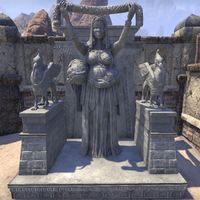
Gypsum alabaster was used extensively by the Lefthanded Elves.[33]
Heart Stone[edit]
A Heart Stone (also spelled Heartstone) is an unusual type of ore mined from deposits which appeared in Solstheim in the Fourth Era. Though deposits of them have been known to exist in the Brothers of Strife ruins in Stonefalls circa 2E 582, it is suspected that the deposits surfaced (or landed on the surface) during the cataclysms of the Red Year; Master Neloth of House Telvanni suspected that the material came from Red Mountain and was flung along with other materials to Solstheim during its eruption, and may continue to land on Solstheim from smaller eruptions. Even two centuries later, they still smolder with the heat of the mountain. These are the molten rocks that lay next to the Heart of Lorkhan for millennia, and some vestige of its power has seeped into them. Heart stones sometimes raise Ash Spawn from the bits of bone buried in the nearby ash. Through trial and error, one of his apprentices learned that a stone was needed to prevent an ash guardian summoned through Conjuration from attacking the caster. The stones can also be used for enchanting purposes.
Ildari Sarothril, a different apprentice of Neloth's, was killed during an experiment but was brought back to life when one of these stones was grafted to her. Ildari learned that a stone could be used to prevent necromantic spells from wearing off. She used them to bolster her necromantic spells used to revive Falx Carius.
Holystone[edit]
Holystone is a light pumice sometimes used to clean the decks of ships.[32]
Limestone[edit]
A common material used in the construction of buildings, limestone forms the base of most Imperial architecture.
Marble[edit]
Marble (?).
Amber marble is often associated with Hollowjack.
Morpholith[edit]
A morpholith is a type of mineral. Common morpholiths such as soul gems can be found within nature.[34]
Quasi-crystalline morpholiths are involved in the creation of sigil stones. These exotic morpholiths occur only in pocket voids of Oblivion and cannot be mined or harvested without Daedric assistance.[34] Daedra are theorized to use enchanted chisels to excavate such exotic morpholiths.[35] Some morpholiths harvested in this manner are inherently unstable and therefore unsuitable for use as sigil stones.[36] Although unstable morpholiths cannot be used to open portals, they do have other uses in various summoning rituals.[37]
Night Pumice[edit]
Night Pumice is sometimes used in crafting ebony equipment.
Nirncrux[edit]
Nirncrux, commonly called red brittle, shake stone, and miner's bane, is a red stone found only in Craglorn. In its raw form, it releases a poisonous gas when cracked which can cause symptoms ranging from nausea, body tremors, and disorientation to convulsions, slurred speech, memory loss and death. One theory on why Nirncrux is abundant in Craglorn is that the Nedes of the area used arcane rituals to draw it from deep within Nirn's crust. Regardless of the validity of this speculation, the Nedes learnt how to harness its ability to absorb and distribute Aetherial energy.
Ochre[edit]
Ochre is an orange clay pigment. Torval Royal Ochre, a rare and valuable pigment that comes from the aforementioned clay is found in the area of Torval.[38]
Petrified Wood[edit]
Potash[edit]
Potash is a kind of ash[39] that has many uses, particularly in Orcish culture. It is sometimes used in equipment reverent of Malacath[40] and in some traditional Orcish ware.[41] It is also known to be used in glassmaking.[39]
Regulus[edit]
Rubber[edit]
Rubber is an elastic material. Throughout Tamriel and beyond, rubber has found a multitude of applications across various cultures.
Rubber mallets, were used to alleviate discomfort associated with arthritic joints, though their effectiveness was a subject of a debate.
In ancient times, Argonians utilized it in the fabrication of their garments. Rubber-soled sandals were a standard choice for footwear among all social classes, often paired with fringed leg wraps, anklets, and shin guards by those of higher status. Modern Argonians also utilize rubber. Teeba-Bassu players of the swampy region of Blackwood were known to employ a hard rubber balls wrapped in death hopper hide, providing them a perfect grip even in the muddiest of conditions. In Murkmire, some of the rubber products were made of the Hist sap. Among the items made with the use of the Hist sap rubber were telescoping wamasu prods. They were properly insulated to protect against the electrical discharges of the wamasu.
Rubber was often used to craft toys. Khajiit and Argonians alike were known to use rubber to craft toys. In Elsweyr, realistic rubber squeeze mouse toys made from cooked gray rubber were designed to amuse and startle with their lifelike squeaking. Argonians were known to craft frog-shaped squeaky toys, known as the squeaky tsonashap. They were made of soft rubber, and were popular among their hatchlings. Rubber was also used for other forms of amusement. Rubber-lined mammoth snout snorkels, perfect for diving, were available and sold by Argonian merchants.
Rubber was also utilized by the denizens of the Clockwork City. Residents of the Sotha Sil's realm have found an unconventional use for rubber, utilizing it in the creation of thermal conductive mesh, which is then encased in cloth and repurposed as a flexible blanket. Clockwork's inventiveness doesn't stop there. Nasal kerchiefs made from remarkably soft rubber squares were favored by some of its residents, despite its haphazard appearance and impractical nature. They also uutilized blood billows, made of rubber bladders. They were manually compressed to aid in the circulation of a patient's blood, ideally by a skilled factotum or someone with a keen sense of rhythm. In the city, thin rubber pouches were employed to store small meals and delicate research samples. They were airtight and suitable for vacuum sealing, aiding in preservation.
Marsh Waders were durable rubber overalls specially designed to effectively shield against both bog water and any potential inhabitants found within them. They were not uncommon in Hew's Bane. Blood rugs were stain-proof and backed with rubber. They were a common sight in Tamriel. Some festive blankets in Western Skyrim were known for vibrant patterned linen on one side, complemented by a waterproof rubber backing on the other, serving as a protective barrier to keep clothing dry during snowy picnics.
Rubber even found its way into the realm of thievery, with heavy clay water jugs featuring well-designed rubber seals. Clever thieves often repurposed these seals for clandestine climbing endeavors.
Sandstone[edit]
Shale[edit]
Shale is a sedimentary rock known for its fine-grained texture and ability to split into thin layers. Orichalcum is often found in brittle shale.
The Bright River-Shale, a rare and gleaming stone, is often employed by the Reachfolk in their religious rituals, and it is found within the Karth River.
Numerous etched shale fragments bearing the remains of an ancient Black Marsh centipedes were in circulation during the Interregnum.
Certain Roister's Club members were known to claim that Dragons were purportedly the originators of the first Tamriel's card game, utilizing sizable shale slabs as their playing cards.
Informally, Ostraekeratic Fever was also known as "shale-skin disease."
Schist[edit]
Schist is a type of rock used in Reachfolk craftsmanship. It found use in Reachfolk art, particularly in the crafting of idols linked to their religious beliefs, including those associated with the Daedric Prince Hircine. As of the year 2E 582, finely crafted stone idols resembling the antlers of Hircine, the Lord of the Hunt, crafted from schist by the Reachfolk and adorned with bone inlays, were discovered throughout Tamriel.
Scoria[edit]
Scoria is a type of volcanic rock formed when lava cools upon exposure to air. Though not typically favored for crafting, it holds great interest among skilled alchemists and scholars.
Vulk'esh Scoria, a special kind of scoria, is acquired from the shed outer crust of the Vulk'esh creatures, believed to possess magical properties. While not considered hazardous when separated from the Vulk'esh body, it was thought to potentially instigate dangerous alchemical reactions. It was considered a rare material coveted by wealthy artisans. Some alchemists in Summerset Isles believed it could be utilized in crafting potions and powders for fire protection. It has a gentle warmth when touched, without being excessively hot. The Firepot in the central High Isle was renowned for its high population of Vul'kesh, making it an excellent location to harvest this material.
Skarn[edit]
Skarn is a metamorphic rock. The Druids of the Firesong Circle were known to craft their weapons and armor from volcanic rock and living skarn sourced from the Mount Firesong, their sacred site, using it for both protection and adornment. They shaped the skarn using volcanic hammers and obsidian implements.
Slate[edit]
Soapstone[edit]
Soapstone (or lipsand in Ayleidoon) is a type of stone, often finely carved, that is used for various purposes. It is commonly used for crafting objects such as meditation beads, replicas of structures, and idols. It can also grant an enchantment the property of poison resistance.
Soapstone was employed in the creation of some devotional items for the Imperial Cult. Certain meditation beads devoted to Akatosh were carefully fashioned using soapstone, adorned with intricate symbols of Akatosh meticulously painted onto their surfaces. Soapstone was utilized to create devotional items for other deities in the pantheon as well, including finely carved representations of Dibella. These soapstone idols, intricately fashioned to resemble the goddess, were thought to enhance the holder's romantic allure when regularly polished.
Soapstone is also employed in the creation of replicas, such as the small Chid-Moska Xanmeer replica. During the Interregnum, soapstone artifacts were discovered on occasion, with some of them taking the shape of miniature carvings resembling xanmeers. At least some of them bore the inscription "Chid-Moska" beneath them, featuring a crudely carved "X" at their apex.
Certain locations bore names inspired by soapstone, such as the ruined Ayleid settlement known as Lipsand Tarn (meaning "Soapstone Delve").
Spellstone[edit]
Spellstone is a magical alloy created by the great mage Shalidor. It is said that Shalidor traveled to multiple Oblivion planes, collecting crystals from at least five different realms. Through a highly perilous transmutation spell, he fused these crystals together to create an alloyed spell-focus.
Sulfur[edit]
Tel Var Stones[edit]
Tel Var Stones are magical pieces of the White-Gold Tower that purportedly contain the essence of Creation. According to Tower Lore, scholars postulate that when the Ayleids built the White-Gold Tower, they couldn't recreate their own Zero Stone, so they settled for Tel Var Stones. It's believed the stones are imbued with vast magical power that lies dormant within. With further study, scholars believe details of the White-Gold Tower's construction could be revealed. Experimentation on powdered stones revealed that all elements of magical practice reside within them. Should the stones be destroyed, some believe that the essence of Creation within them is lost.
Tuff[edit]
Tuff is a type of rock formed from volcanic ash and fragments that have been compacted and cemented together. Red Mountain ash from its eruption could be found in tuff around Lake Rumare during the Second Era. It was used as an ingredient in an alcoholic beverage called Nirnroot Wine.
References[edit]
- ^ Agonymium Stone, Inert furnishing in ESO
- ^ Agonymium Stone memento in ESO
- ^ Agonymium Stones in the Dread Cellar in ESO
- ^ High Isle Concept Art
- ^ Remnants of Cyrod
- ^ Ayleid Crate description
- ^ a b The Elder Scrolls V: Skyrim: Prima Official Game Guide — David Hodgson
- ^ Hand Kenro's Note
- ^ Basalt Table-Game Set antiquity codex entry in ESO: Greymoor
- ^ Vivec Palace art
- ^ Porcelain Teapot in ESO
- ^ Mobar Mine loading screen in ESO
- ^ Crock of Packing Mud in ESO
- ^ The Red Paint
- ^ Legends of the Forest — the Sisters Glumm
- ^ Xal-Toh Tablet in ESO
- ^ Events of A Sticky Solution in ESO: Clockwork City
- ^ Painted Coal and Embers body markings in ESO
- ^ Onyx Indrik's default name in ESO
- ^ Fulgurite Forger in ESO: Stonethorn
- ^ Rock, Gabbro Set, Rock, Wide Gabbro Slab, Rock, Gabbro Boulder Cluster, Rock, Gabbro Boulder in ESO
- ^ Sweetwater Cascades in ESO
- ^ Tormented Spire loading screen text in ESO
- ^ Charred Ridge loading screen text in ESO
- ^ Foyada Quarry loading screen text in ESO: Morrowind
- ^ The Improved Emperor's Guide to Tamriel: Northern Bangkorai and the Mountains — Flaccus Terentius, 2E 581
- ^ Holdings of Jarl Gjalund — Slafknir the Scribe
- ^ The Improved Emperor's Guide to Tamriel: Skyrim — Flaccus Terentius, 2E 581
- ^ The Improved Emperor's Guide to Tamriel: The Summerset Isles: Auridon — Flaccus Terentius, 2E 581
- ^ Auridon in ESO
- ^ The Song of Pelinal, v 3
- ^ a b Coldrock Diggings loading screen in ESO
- ^ Morwha's Blessing in ESO
- ^ a b Liminal Bridges — Camilonwe of Alinor
- ^ Ancient Morpholith Chisel Antiquities Codex in ESO
- ^ Unstable Morpholith pet in ESO
- ^ Unstable Morpholith fragment upgrades in ESO
- ^ Ball of Royal Ochre Mohair Yarn description in ESO
- ^ a b Cheeses of Skyrim: Whiterun, Winterhold, Eastmarch — B.
- ^ Potash in ESO
- ^ Worn Orcish Cauldron in ESO
Note: The following references are considered to be unofficial sources. They are included to round off this article and may not be authoritative or conclusive.
- ^ High Isle Chapter Preview
- ^ Ted Peterson's posts in Playing Houses
- ^ EditorIDs of static objects on Solstheim in Skyrim
